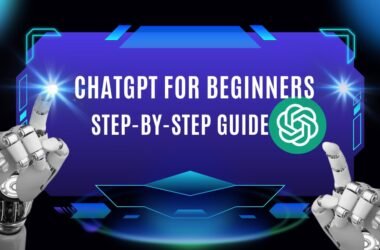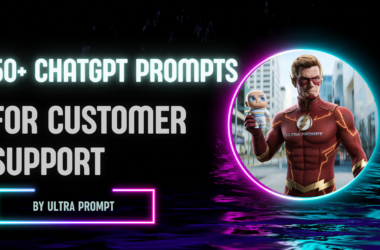In today’s digital world, video content is king. Whether you’re a tech-savvy entrepreneur launching a new product, a marketing pro crafting engaging campaigns, or a content creator building your online presence, video is the key to capturing attention and driving results. But creating high-quality videos that resonate with your audience requires more than just fancy visuals—it all starts with a compelling script.
As professionals, we’re always looking for ways to optimise our workflows and maximise efficiency. And that’s where the magic of AI comes in. ChatGPT, the powerful language model developed by OpenAI, is revolutionising the way we write, and it’s a game-changer for video scriptwriting.
This blog post goes beyond the basic ChatGPT prompts you might find elsewhere. We’ll equip you with the knowledge and techniques to craft professional-level prompts, navigate ethical considerations, and seamlessly integrate ChatGPT into your video production process.
Understanding ChatGPT’s Power for Scriptwriting
What exactly is ChatGPT? In simple terms, it’s an AI that’s been trained on a massive amount of text data, enabling it to understand and generate human-like language with remarkable accuracy. For scriptwriters, this means having an AI assistant that can help you brainstorm ideas, draft scenes, write dialogue, and even provide feedback on your work.
How does it work for scriptwriting? You start by providing ChatGPT with a prompt—a set of instructions that tells it what you want it to write. The more detailed and specific your prompt, the better the results. ChatGPT then processes your prompt and generates text based on your instructions. You can then review, edit, and refine the output to create a polished script.
The benefits for professionals are undeniable:
- Time-Saver: Say goodbye to staring at a blank page! ChatGPT can generate script ideas and drafts in minutes, freeing you up to focus on other aspects of your project.
- Creativity Booster: Sometimes, we all hit a creative wall. ChatGPT can help you break through those blocks by generating fresh ideas, exploring alternative storylines, and offering unique perspectives you might not have considered.
- Quality Enhancer: A well-crafted ChatGPT prompt can help you produce well-structured, engaging, and informative scripts that resonate with your target audience.
Crafting Effective Prompts: The Key to Success
The quality of your ChatGPT output is directly tied to the quality of your prompts. Think of it like giving instructions to a human writer—the clearer and more detailed your instructions, the better the final product.
Here’s the catch: Generic prompts lead to generic results. If you simply ask ChatGPT to “write a product review script,” you’ll likely get a bland, cookie-cutter output that lacks personality and impact.
To unlock ChatGPT’s full potential, you need to master the art of crafting specific, targeted prompts. Let’s break down the essential elements:
- Video Type and Platform: Tell ChatGPT exactly what kind of video you’re making and where it will be published. Are you creating an explainer video for YouTube, a motivational Reel for Instagram, or a product demo for LinkedIn? The platform and format will heavily influence the tone, style, and length of your script.
- Target Audience: Who are you trying to reach with your video? Specify your target audience’s demographics, interests, knowledge level, and pain points. This helps ChatGPT generate content that’s relevant, engaging, and tailored to their needs.
- Desired Tone and Style: Do you want your script to be formal and informative, casual and conversational, or humorous and entertaining? Specify the tone and style to ensure ChatGPT aligns with your brand voice and messaging.
- Key Messages and Call to Action: What are the core messages you want your video to convey? What action do you want your viewers to take after watching? Clearly state your key messages and desired call to action in your prompt.
- Visual Considerations: Don’t limit your prompts to just text! You can push ChatGPT to generate creative visual ideas as well. Try asking it to create visual metaphors, describe specific scenes, or suggest dynamic camera movements. For example, instead of just saying “show the product,” you could prompt it with “visually demonstrate the product’s key features in a way that highlights its ease of use.”
Advanced Prompt Engineering for Professional Results
Once you’ve mastered the basics, it’s time to level up your prompt engineering skills and unlock ChatGPT’s full potential for professional scriptwriting.
Here are some advanced techniques to refine your prompts and get exceptional results:
- Iterative Prompting: Don’t settle for ChatGPT’s first response! Experiment with rephrasing your prompt, adding more details, or requesting alternative versions until you achieve the desired outcome. You can even use simple prompts like “Try again” to signal ChatGPT to generate a new response based on the previous prompt.
- Conditional Statements: Introduce “if-then” statements and other conditional logic to tailor ChatGPT’s output based on specific criteria. For instance, you could prompt it to “write a product demo script that focuses on feature X if the target audience is tech-savvy, but focus on ease of use if the audience is less technical.”
- Fine-Tuning Output Style: Want ChatGPT to write in a specific voice or style? You can guide it by providing examples of writing that you like. For instance, you could include a sample script from a competitor’s video and ask ChatGPT to emulate that style.
Ethical Considerations and Potential Pitfalls
While ChatGPT is a powerful tool, it’s essential to use it responsibly and ethically. Here are some crucial considerations:
- Plagiarism and Originality: Always review ChatGPT’s output carefully to ensure it’s original and doesn’t infringe on anyone’s copyright. While the technology is impressive, it can sometimes generate text that closely resembles existing content. You can use plagiarism detection tools to double-check.
- Bias and Representation: AI models are trained on massive datasets, and these datasets can contain inherent biases. Be mindful of potential biases in ChatGPT’s output, especially when dealing with sensitive topics. Critically evaluate the content to ensure it’s fair, inclusive, and aligned with your values.
- Over-Reliance on AI: ChatGPT is a fantastic tool, but it’s not a replacement for human creativity and judgement. Use it to enhance your workflow, not to replace it entirely. Always review, edit, and add your personal touch to ensure the final script reflects your unique voice and vision.
Integrating ChatGPT into Your Video Production Workflow
ChatGPT can be seamlessly integrated into your professional video production process. Here’s how:
- Initial Drafting and Idea Generation: Use ChatGPT to quickly generate first drafts, brainstorm different storylines, or explore alternative dialogue options. This can save you hours of time and help you overcome writer’s block.
- Collaboration with Human Expertise: The best results come from combining AI’s power with human creativity. Use ChatGPT as a starting point, then work with your team of scriptwriters, editors, and producers to refine the output, fact-check information, ensure brand consistency, and add that all-important human touch.
- Compatibility with Scriptwriting Software: ChatGPT’s output can easily be pasted into professional scriptwriting software for formatting and production management. This helps streamline your workflow and maintain a consistent format across your projects.
Beyond Scriptwriting: Exploring Other AI Tools
The AI revolution in video production extends far beyond scriptwriting. Here are a few other AI-powered tools worth exploring:
- AI Video Generators: Tools like Fliki and Zubtitle allow you to create videos directly from text or audio. They offer various features, including AI voiceovers, stock footage, and customizable templates.
- AI Video Editing Tools: AI is transforming video editing with features like automated scene detection, object tracking, and intelligent colour grading. These tools can significantly speed up your editing process and help you create polished videos with less effort.
Embrace the Future of Scriptwriting
The rise of AI in content creation is undeniable, and ChatGPT is at the forefront of this revolution. By mastering the art of prompt engineering and integrating AI thoughtfully into your workflow, you can unlock new levels of efficiency, creativity, and quality in your video production process.
Don’t be afraid to experiment, iterate, and push the boundaries of what’s possible. The future of scriptwriting is here, and it’s powered by AI.
Ready to put your skills to the test? Share your ChatGPT prompt experiments and video creation experiences in the comments below!




